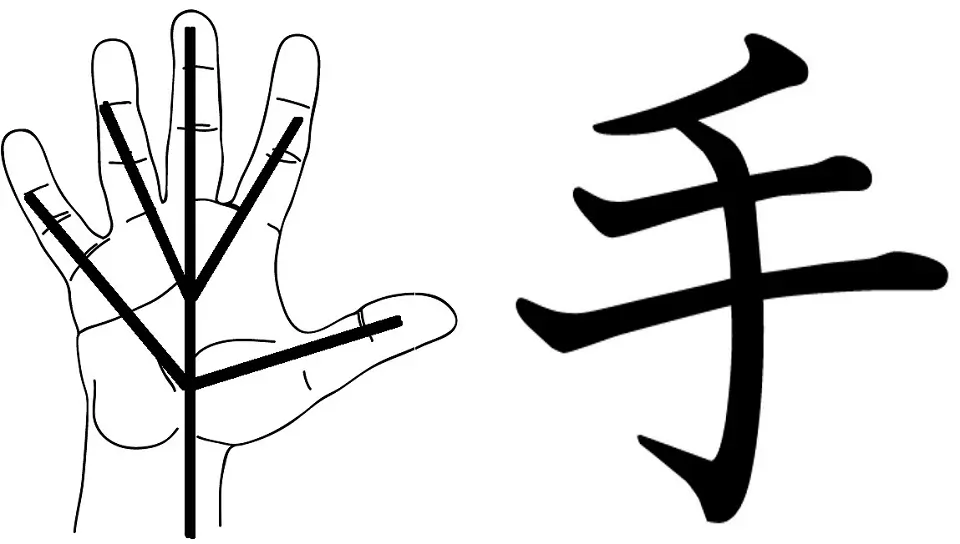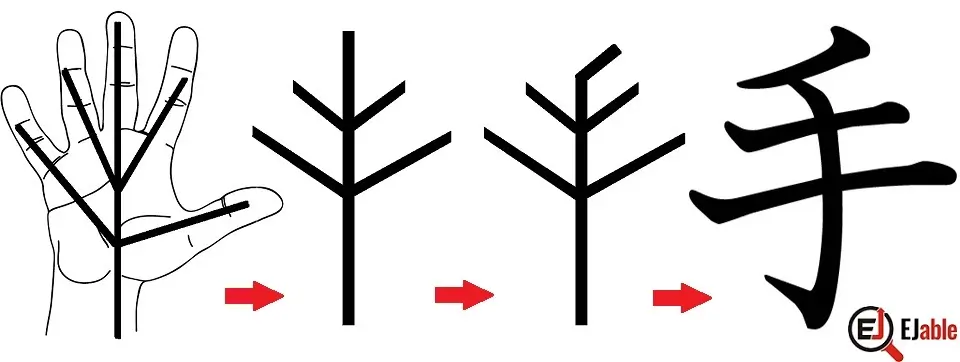Kanji for Hand (手)

The Japanese kanji for “hand” is 手 (read as “te”). This kanji is pronounced “te” or “ta” in its kun’yomi reading and “shu” in its on’yomi reading.
Hand’s Kanji is constructed with 4 strokes. This Kanji is a part of the JLPT N4 syllabus (please check the list of JLPT N4 kanji) and is taught in grade 1 in Japanese schools.
This article will discuss the origin of Hand’s Kanji and easy ways to remember it. We will also discuss the radicals of this Kanji and the compounded words in which 手 appears.
Other meanings of 手:
While the primary meaning of 手 is “hand,” it is also used in various compound words and phrases to indicate things related to hands or, more abstractly, to suggest personal involvement or effort. For instance:
- 手紙 (tegami): Letter (as in a piece of correspondence)
- 手間 (tema): Time and effort invested in an activity.
- 手伝う (tedazukau): To help; to assist
Furthermore, in some compounded Kanji characters, 手 refers to ‘means’, ‘method’, or ‘measure’, like in 手段 (shudan).
In modern Japanese, 手 is seen in everyday words and phrases. For instance, 手前 (temae) means “in front” or “this side,” but it can also imply something closer to oneself.
Origin and Construction of the Kanji 手 (te or ta) for Hand
Hand’s Kanji illustrates the palm of a hand with 4 strokes.
The ancient forms of this character depicted a hand, sometimes including part of the arm. Over time, the depiction became more stylized, evolving into the modern character. In essence, its origin is quite straightforward, representing the object it describes.
Like many kanji, 手 has its roots in ancient Chinese pictographs. In its earliest forms, this character resembled an actual hand, including part of the arm and the palm. Over millennia, this representation has evolved, simplifying and becoming more abstract, leading to the character we recognize today.
How to Remember the Hand’s Kanji 手
The best way to remember the Kanji is the above-explained origin of the shape of 手.
Some may question that the shape does not resemble a palm with fingers. However, please remember that even though Kanji characters are pictograms of the objects they represent, they are simplified in such a way that anyone can write them.
The following illustration will serve as a mnemonic to remember the Japji of hand, as well as to explain the evolution of the shape of this Kanji:

Cultural Significance:
Hands have always held deep cultural and spiritual significance in many cultures, including Japanese. They symbolize human agency, capability, and interaction. This is evident in the vast array of idiomatic expressions in the Japanese language that feature the kanji for hand, reflecting various aspects of life, from relationships to work and craft.
Kanji 手 of Hand as a Radical
The Kanji for hand also serves as a Kanji radical, meaning it appears as a component in other Kanji characters, commonly referred to as the “hand radical. Hand’s Kanji appears as a radical or subcomponent in 40 Kanji characters, including 7 Jōyō Kanji.
Please note that the hand radical “手” also has a shape variant in the form of 扌. As a radical, it often imparts meanings related to “hand” or actions done by hand.
For example, 持 (mochi, meaning “to hold”) has the hand radical on the left side, indicating a hand-related action. Top of Form
Following are some examples of Kanji characters with the radical of the Kanji of hand, i.e., 手 and 扌:
- 持 (mochi): To hold or possess.
- 打 (utsu): To hit or strike.
- 推 (osu): To push or recommend.
- 挙 (agaru): TTo raise or elevate.
- 捕 (toru): To catch or capture.
- 描 (egaku): To draw or describe.
- 携 (motsu): To carry (in hand).
- 投 (tou): To throw or cast.
- 指 (yubi): Finger or to point.
- 探 (sagasu): To search or look for.
- 捨 (suteru): To throw away or discard.
- 握 (nigiru): To grasp or grip.
- 操作 (sousa): Operation or manipulation.
- 摘 (tsumu): To pick or pluck.
- 提 (tei): To propose or suggest.
These examples show that many kanji with the hand radical pertain to actions done with the hands or relate to concepts associated with hands in some way.
Compound Words (Kanji) Using 手
The Kanji for the Hand frequently appears in compounded Japanese words’ kanji characters. There are 580 Japanese words that begin with the Kanji 手, and it appears in 1420 words
Here are some compounded words using the kanji for “hand” (手):
- 手紙 (tegami): Letter (as in a correspondence).
- 手術 (shujutsu): Surgery.
- 手段 (shudan): Means or method.
- 手話 (shuwa): Sign language.
- 手帳 (techou): Notebook or planner.
- 手続き (tetsuzuki): Procedure or process.
- 手元 (temoto): At hand or nearby.
- 手足 (teashi): Hands and feet.
- 手前 (temae): In front of oneself, or sometimes used to mean “you” in a rude or colloquial manner.
- 手首 (tekubi): Wrist.
- 手助け (tedasuke): Help or assistance.
- 手品 (tejina): Sleight of hand, magic trick.
- 手間 (tema): Time and effort, trouble.
- 手頃 (tegoro): Affordable, reasonable.
- 手荷物 (tenimotsu): Hand luggage or baggage.
Check other Kanji characters on the page “How to Learn Kanji“.

A long-term ex-pat in Japan, Himanshu comes with an IT background in SAP consulting, IT Business Development, and then running the country operations of an IT consulting multinational. Himanshu is the co-founder and Managing Director of ReachExt K.K. and EJable.com. He is also an Advisory Board Member of a Silicon Valley AI/IoT startup.
